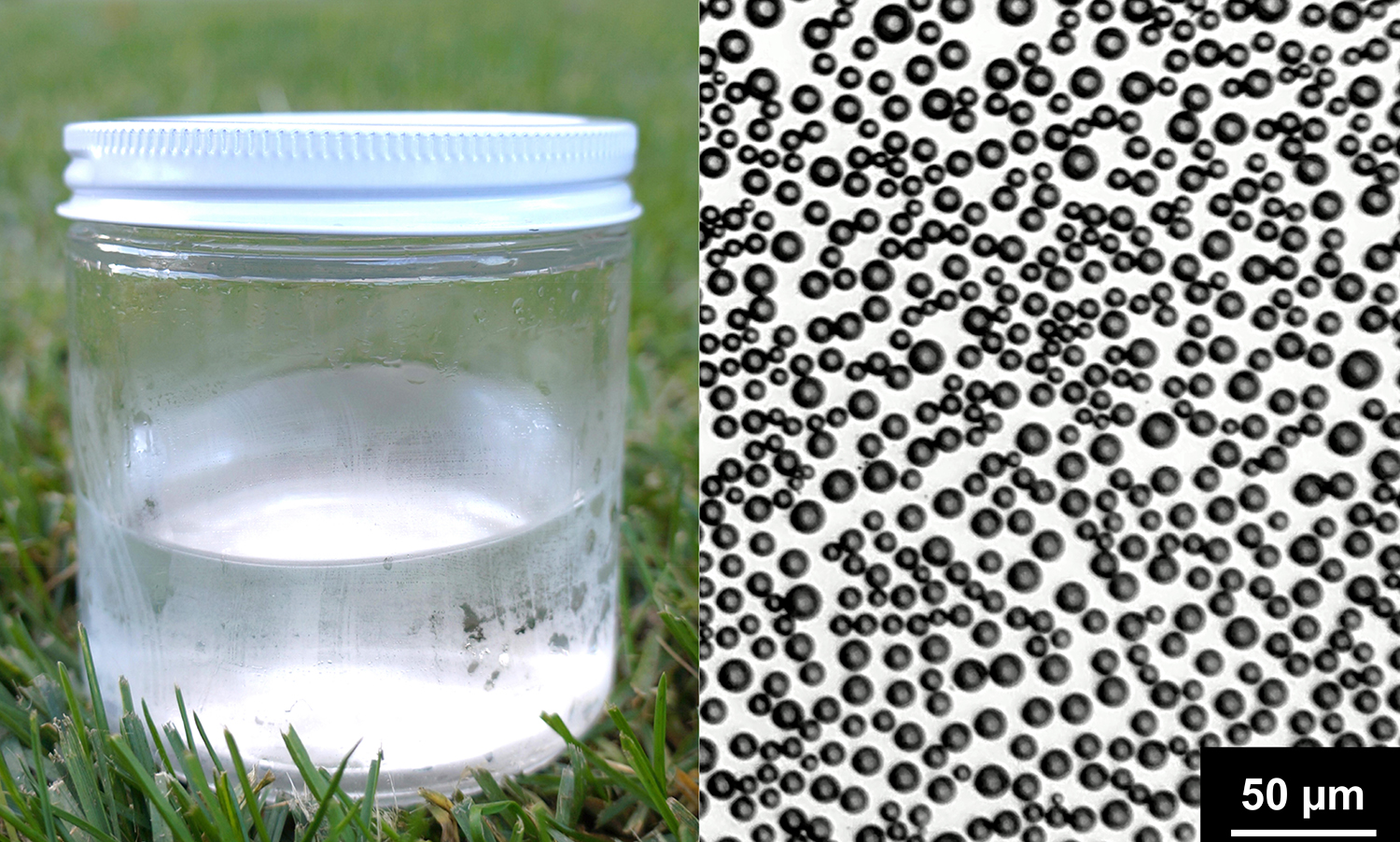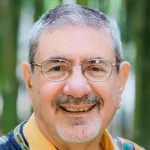
Image by Berislav Kovacevic, Shutterstock.
Stanford News - November 23rd, 2020 - by Adam Hadhazy
In its bulk liquid form, whether in a bathtub or an ocean, water is a relatively benign substance with little chemical activity. But down at the scale of tiny droplets, water can turn surprisingly reactive, Stanford researchers have discovered.

Image courtesy Jae Kyoo Lee and Hyun Soo Han: Photo shows water
microdroplet condensate formed on the surface of a glass container
containing cold water (left) and an image of water microdroplets
formed on a polished silicon surface (right).
In microdroplets of water, just millionths of a meter wide, a portion of the H2O molecules present can convert into a close chemical cousin, hydrogen peroxide, H2O2, a harsh chemical commonly used as a disinfectant and hair bleaching agent.
Stanford scientists first reported this unexpected behavior in forcibly sprayed microdroplets of water last year. Now in a new study, the research team has shown the same Jekyll-and-Hyde transformation happens when microdroplets simply condense from the air onto cold surfaces. The new results suggest that water’s hydrogen peroxide transformation is a general phenomenon, occurring in fogs, mists, raindrops and wherever else microdroplets form naturally.
The surprising discovery could lead to greener methods for disinfecting surfaces or promoting chemical reactions. “We’ve shown that the process of forming hydrogen peroxide in water droplets is a widespread and surprising phenomenon that’s been happening right under our noses,” said study senior author Richard Zare, the Marguerite Blake Wilbur Professor in Natural Science and a professor of chemistry in the Stanford School of Humanities and Sciences.
The researchers also speculate that this newly recognized chemical ability of water could have played a key role in jumpstarting the chemistry for life on Earth billions of years ago, as well as produced our planet’s first atmospheric oxygen before life emerged. “This spontaneous production of hydrogen peroxide may be a missing part of the story of how the building blocks of life were formed on early,” Zare said.
The co-lead authors of the new study, published in Proceedings of the National Academy of Sciences, are Stanford staff scientists Jae Kyoo Lee and Hyun Soo Han.
Along with Zare and other Stanford colleagues, Lee and Han made the initial discovery of hydrogen peroxide production in water microdroplets last year. Some outside researchers who went over the study’s results were skeptical, Zare said, that such a potentially common phenomenon could have gone undiscovered for so long. Debate also ensued over just how the hydrogen peroxide would ever actually form.
“The argument was that people have been studying water aerosols for years, and of course water is ubiquitous and has been intensively studied since the dawn of modern science, so if this hydrogen peroxide formation in microdroplets were real, surely someone would have seen it already,” said Zare. “That led us to want to explore the phenomenon further, to see in what other circumstances it might occur, as well as learn more about the fundamental chemistry going on.”
Microdroplets made another way
Zare and colleagues decided to investigate condensation, a scenario where microdroplets readily form naturally, without the aid of an external force such as a nebulizer instrument. Condensation occurs when water vapor (gas) in the air transitions into a liquid upon contacting a cooler surface; for instance, when the bathroom mirror fogs over after a shower.
The Stanford team condensed water into multiple chilled materials, including silicon, glass, plastic and metal. The researchers then wiped a test strip that changes color in the presence of hydrogen peroxide over the condensed water. Sure enough, the strip turned blue. The low, yet detectable amounts of hydrogen peroxide (on the order of parts per million) that formed varied based on factors such as the temperature of the surface and the relative humidity in the test chamber. The researchers also noted that the hydrogen peroxide formed in microdroplets became diluted as the size of the water droplets grew, which might explain why this chemical transformation had been overlooked for so long.

Courtesy of the Zare lab: Watch the video! This sped-up video
shows hydrogen peroxide forming amidst condensed water
microdroplets.
The new experiments also support the researchers’ initial hypothesis about how the hydrogen peroxide was forming. They demonstrated that a strong electric field generated at the interface of water and air, right at the microdroplet’s periphery, seems to activate water molecules, forming various so-called reactive oxygen species. These species are unstable molecular fragments that can quickly react with other molecules to yield hydrogen peroxide.
A process always with us and well before us
Chemistry of this sort at the microdroplet level could have empowered the chemical transition from non-life to life on Earth over four eons ago, Zare said. The origin of life has a sort of chicken-or-egg dilemma, where catalyst molecules that speed up chemical reactions, and which appear necessary to jumpstart the chemistry of life, require life itself to make the catalyst molecules in the first place. But the natural creation of hydrogen peroxide could have instead promoted reactions leading to the molecular building blocks that ultimately assembled into complex, self-replicating entities.
Zare speculates that this ancient and widespread chemical reaction could have even provided a source of oxygen for early life (since hydrogen peroxide breaks down into water and oxygen molecules) before the appearance of organisms that could produce oxygen themselves through photosynthesis.
Zare’s team is presently looking into how hydrogen peroxide production via microdroplets might be harnessed for cleaning and disinfecting purposes. One intriguing possibility, Zare suggests, is using microdroplets and their attendant H2O2 to eliminate SARS-CoV-2 (the virus that causes COVID-19) from surfaces.
“With this new study and our continuing work, we’re explaining how and why water droplets are so markedly different from bulk water in terms of chemical reactivity,” said Zare. “It’s amazing that chemistry-wise, water still has some tricks up its sleeve.”
Additional Stanford authors include Robert Waymouth, the Robert Eckles Swain Professor in Chemistry; Fritz Prinz, the Leonardo Professor and a professor of mechanical engineering and of materials science and engineering; and PhD students Settasit Chaikasetsin in mechanical engineering and Daniel P. Marron in chemistry.
Zare is also a member of Stanford Bio-X, the Cardiovascular Institute, the Stanford Cancer Institute, Stanford ChEM-H, the Stanford Woods Institute for the Environment and the Wu Tsai Neurosciences Institute.
The research was funded in part by a grant from the U.S. Air Force Office of Scientific Research and the Volkswagen Group of America.


